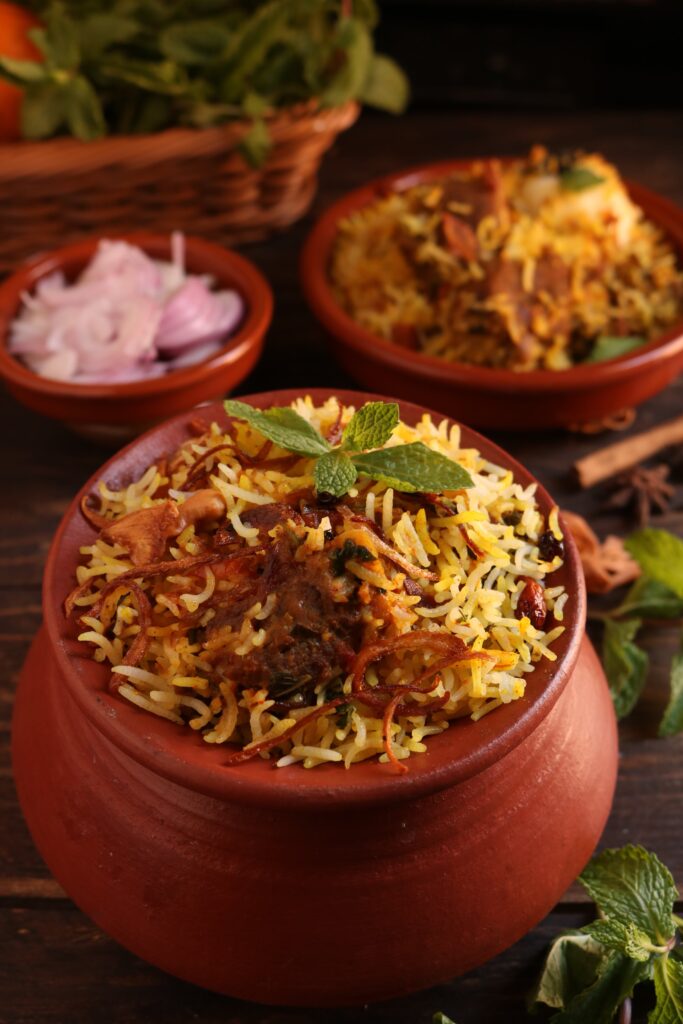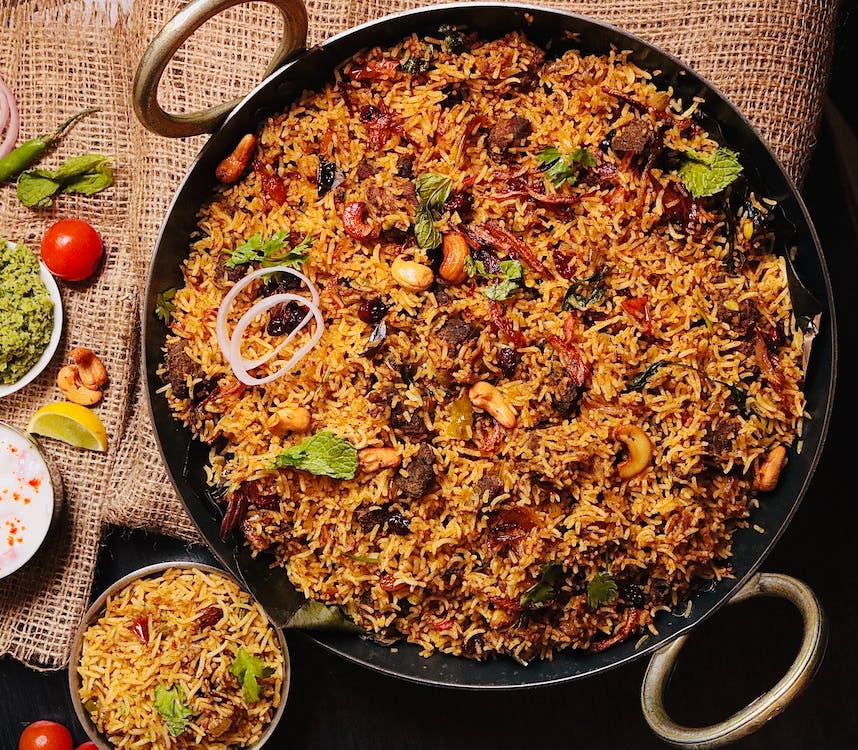Biryani, a fragrant and flavorful dish, stands as a testament to the rich tapestry of Indian cuisine. This aromatic one-pot wonder has captivated the hearts and palates of millions around the globe, transcending cultural boundaries and establishing itself as a culinary masterpiece. Originating from the Indian subcontinent, biryani has evolved into various regional interpretations, each offering a unique blend of spices, textures, and aromas. Let’s embark on a journey into the world of biryani, exploring its history, diverse varieties, and the artistry behind its creation

Historical Roots:
The origins of biryani can be traced back to the Indian subcontinent, with historical narratives suggesting its introduction during the Mughal era. Legend has it that the dish was developed to satiate the nutritional needs of Mughal soldiers, combining rice, meat, and aromatic spices for a wholesome and hearty meal. Over time, biryani adapted and transformed as it traveled across regions, incorporating local ingredients and culinary traditions.

Varieties Across the Subcontinent:
Biryani is not a monolithic dish; rather, it is a culinary umbrella that shelters an array of regional variations, each with its own distinct personality. Some notable varieties include:
- Hyderabadi Biryani: Hailing from the southern city of Hyderabad, this biryani is characterized by the use of fragrant Basmati rice, marinated meat (usually chicken or mutton), and a unique blend of spices, including saffron and mint.
- Lucknawi Biryani: Originating from the city of Nawabs, Lucknow, this biryani is known for its tender meat (often beef or buffalo), long-grain Basmati rice, and an artistic touch of aromatic spices, saffron, and rose water.
- Kolkata Biryani: A sweet and subtle variation, the Kolkata biryani features aromatic rice, succulent meat (typically goat or chicken), and is distinguished by the inclusion of boiled eggs and mild spices.
- Malabar Biryani: Originating from the Malabar region in Kerala, this biryani incorporates local flavors such as coconut, curry leaves, and Malabar spices. It often features seafood or locally sourced meat.
The Biryani-making Process:
The art of crafting biryani is a labor of love, requiring precision, patience, and a keen understanding of flavors. The process typically involves marinating meat in a blend of yogurt and spices, partially cooking the rice, and then layering the marinated meat and semi-cooked rice in a pot. The biryani is then slow-cooked, allowing the flavors to meld, and the aroma to permeate every grain of rice. The result is a harmonious symphony of textures and tastes that tantalize the taste buds.
Beyond Borders:
Biryani’s popularity extends far beyond the Indian subcontinent, finding its way into the hearts and plates of food enthusiasts worldwide. It has become a staple in Middle Eastern, Southeast Asian, and even Western cuisines, with various adaptations and interpretations reflecting the diverse global palate.
Conclusion:
Biryani, with its rich history and diverse regional variations, is more than just a dish – it’s a cultural celebration on a plate. The meticulous blend of spices, the careful layering of ingredients, and the slow-cooking process all contribute to biryani’s status as a culinary masterpiece. Whether enjoyed during festive occasions, family gatherings, or casual dinners, biryani is a feast for the senses, inviting us to savor the intricate flavors and aromas that make it an enduring symbol of gastronomic excellence.
Some popular types of biryani from different regions
- Hyderabadi Biryani: Fragrant Basmati rice, marinated meat (usually chicken or mutton), and a unique blend of spices, including saffron and mint.
- Lucknawi Biryani: Tender meat (often beef or buffalo), long-grain Basmati rice, and an aromatic mix of spices, saffron, and rose water.
- Kolkata Biryani: A sweet and subtle variation featuring aromatic rice, succulent meat (typically goat or chicken), boiled eggs, and mild spices.
- Malabar Biryani: Originating from Kerala, it includes local flavors like coconut, curry leaves, and Malabar spices. Often made with seafood or locally sourced meat.
- Ambur Biryani: Hailing from Tamil Nadu, it features short-grain rice, seeraga samba, and is known for its spiciness and the use of curd (yogurt) in the marinade.
- Thalassery Biryani: Another Kerala specialty, it incorporates Khaima or Jeerakasala rice and is often made with chicken or mutton. It includes a unique blend of spices.
- Dindigul Biryani: Originating from Tamil Nadu, it’s characterized by its flavorful seeraga samba rice and the use of curd and lemon in the marinade.
- Sindhi Biryani: A Pakistani variation known for its spicy and tangy flavor, often made with basmati rice, and includes yogurt, potatoes, and various aromatic spices.
- Memoni Biryani: Originating from the Memon community in India, it’s a spicy and flavorful biryani often made with goat meat and basmati rice.
- Bombay Biryani: A Mumbai street food favorite, it’s a flavorful biryani often made with a combination of meats, fragrant basmati rice, and spiced with Bombay-style masalas.
Remember, the variations are numerous, and each region may have its own unique take on biryani, creating a diverse and delicious tapestry of flavors across the Indian subcontinent and beyond.

Chicken Biryani
Certainly! Here’s a basic recipe for Chicken Biryani, one of the most popular variations. Keep in mind that specific ingredients and steps may vary based on regional preferences.
Chicken Biryani Recipe
Ingredients:
- 2 cups Basmati rice
- 500g chicken, cut into pieces
- 1 cup yogurt
- 1 cup fried onions (birista)
- 1/2 cup cooking oil or ghee
- 2 large onions, thinly sliced
- 2 tomatoes, chopped
- 1/4 cup chopped mint leaves
- 1/4 cup chopped coriander leaves
- 2 teaspoons ginger-garlic paste
- Whole spices (bay leaves, cloves, cardamom, cinnamon)
- Biryani masala powder
- Red chili powder
- Turmeric powder
- Saffron strands soaked in warm milk (for garnish)
- Salt to taste
Instructions:
- Marinate the Chicken:
- In a bowl, mix the chicken pieces with yogurt, biryani masala powder, red chili powder, turmeric powder, salt, and half of the fried onions. Let it marinate for at least 30 minutes.
- Parboil the Rice:
- Rinse the Basmati rice until the water runs clear. Soak the rice for 30 minutes.
- Boil water in a large pot. Add a pinch of salt and the soaked rice. Parboil the rice until it’s 70-80% cooked. Drain the water and set aside.
- Cook the Chicken:
- In a large pot or deep pan, heat oil or ghee. Add the sliced onions and sauté until golden brown.
- Add ginger-garlic paste and sauté until the raw smell disappears.
- Add the marinated chicken and cook until it’s partially cooked and the spices are well incorporated.
- Layering the Biryani:
- In the same pot, layer half of the parboiled rice over the partially cooked chicken.
- Sprinkle chopped mint and coriander leaves, fried onions, and some biryani masala powder over the rice.
- Layer the remaining rice on top.
- Dum Cooking:
- Sprinkle saffron-soaked milk on the top layer of rice.
- Cover the pot with a tight-fitting lid or seal with dough to create a dum effect.
- Cook on low heat for 20-25 minutes until the rice is fully cooked and the flavors meld together.
- Serve:
- Gently fluff the biryani with a fork.
- Serve hot, garnished with additional fried onions, mint, and coriander leaves.
Enjoy your homemade Chicken Biryani, a delightful blend of aromatic spices, tender chicken, and fragrant Basmati rice!
To know more about Biryani Please click Here
You may like:
Symphony of Sips: 150 Smoothie Recipes to Delight Your Palate
